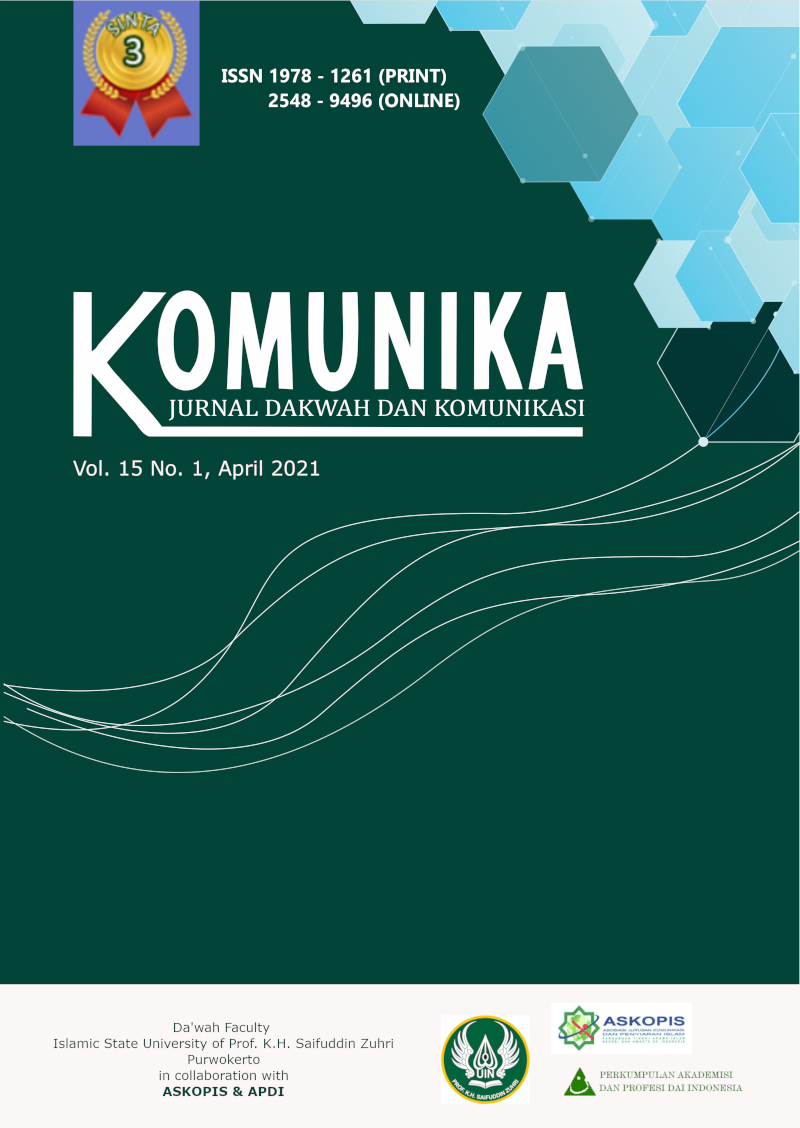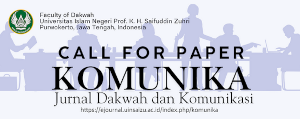Habib Husein Jafar Al-Hadars Da'wa Content Commodification on Youtube
(The Piety Expression and New Discourse in Religiousness Contestation in the Contemporary Era)
DOI:
https://doi.org/10.24090/komunika.v15i1.3986Keywords:
Habib Husein Jafar Al-Hadar, da’wa content commodification, religiousness contestationAbstract
Advances in technology and information provide new opportunities for preachers to be able to take part in spreading Islamic teachings through various social media platforms. One of the preachers who took the role to preach through social media was Habib Husein Jafar al-Hadar. This article examines Habib Husein Jafars missionary activities on the social media platform he uses, Youtube. The researcher analyzes the data by observing virtually and visually (virtual ethnography) on the dakwa content displayed by Habib Husein Jafar through Youtube. The study shows that: 1) the attention to the spiritual enlightenment efforts of the younger generation is the basis of the selection of the social media platform Youtube - because based on previous research, the users of this social media platform are 18-29 years of age; 2) starting from the dakwa consumers who are primarily young people, the content they present is suitable to their needs and lifestyle and 3) by using the concept of the circuit of culture analysis, Habib Husein Jafar in various ranges can reconstruct people's perception of ones definition of holiness. It is not limited based on normative appearance - cloaked and sacrificed, for example - but more on the substantive side, namely by behaving and having knowledgeable skills. With the variety of content, he could visualize himself as a pious young man by not abandoning his social status as a young person.Downloads
Download data is not yet available.
References
Alatas, Ismail Fajri. (2011). Becoming Indonesians: The Ba'alawi in the Interstices of the Nation. Die Welt de Islams, 51 (1), 45-74. DOI: 10.2307/41105369
Baidu. (2014). Jelajah Dunia Mobile di Indonesia Jakarta: Baidu.
Bohang, F. K. Berapa Jumlah Pengguna Internet Indonesia? Diakses dari https://tekno.kompas.com/read/2018/02/22/16453177/berapa-jumlah-pengguna-internet-indonesia
Bukhari. (2015). Penerimaan dan Penolakan Pesan Dakwah dalam Interaksi Simbolik Dai dan Mad'u pada Jamaah Tabligh di Kota Padang. Jurnal Miqot, 39 (2), 377-389. https://dx.doi.org/10.30821/miqot.v39i2.31
Castillo, Imran. M. Castillo. C. Diaz & S. Vieweg. (2018). Processing Social Media Messages in Mass Emergency: A Survei. ACM Computing Surveys. https://doi.org/10.1145/2771588
Denzin, N. K. (2001). The Seventh Moment: Qualitative Inquiry and the Practices of a More Radical Consumer Research. The Journal of Consumer Research. https://doi.org/10.1086/322907
Dwijaya, G. M. & D. A. Zuliestiana. (2017). Analising Positioning Youtuber Indonesia berdasarkan Persepsi Penonton Youtube dengan Menggunakan Metode Perceptual Mapping; Studi pada Kategori Entertainment dengan Konten Berbasis Vlog. E-Proceeding of Management. 4(3), 2267-2271.
Edy, Chandra. (2017). Youtube, Citra Media Informasi Interaktif atau Media Penyampaian Aspirasi PribadI. Mutiara: Jurnal Ilmu Sosial Humaniora dan Seni. 1(2). https://doi.org/10.24912/jmishumsen.v1i2.1035
Fakhruroji. (2019). Muslims Learnings Islam on Internet dalam M. Woodward & R. Lukens-Bull (Eds.). Handbook of Contemporary Islam and Muslim Lives. https://doi.org/19.1007/978-3-319-73653-2_70-1
Hall, S. (1997). Representation: Cultural Representations and Signifying Practices. S. Hall (Ed.). Culture. Media & Identities. London: The Open University & Sage Publications Ltd.
Hall, S. (1997). The Centrality of Culture: Notes on the Cultural Revolutions of Our Time. K. Thomson (Ed). Media and Cultural Regulation Cultures. Media and Identities Series. Edisi 1. London: Sage Publikations in Association with The Open University.
Hogg, M. A. & K. M. White. (2017). A Tale of Two Theories: A Critical Comparison of Identity Theory with Social Identity Theory. Social Psychology Quarterly Social Psychology Quarterly, 58(4). https://doi.org/10.2307/2787127
Ibrahim, I. S. & B. A. Akhmad. (2014). Komunikasi dan Komodifikasi: Mengkaji Media dan Budaya dalam Dinamika Globalisasi. Jakarta: Yayasan Obor Indonesia.
Ilahi, W. (2013). Komunikasi Dakwah. Bandung: Rosdakarya.
Komalasari, Ida (2012). Karakteristik Bahasa Ceramah Ustadz Abdul Somad di Youtube. Prosiding Seminar Nasional Linguistik VII.
Labas, Y. N. dan Yasmine, D. I. (2017). Komodifikasi di Era Maasyarakat Jejaring: Studi Kasus Youtube di Indonesia. Jurnal Peemikiran Sosiologi. 4(2). https://doi.org/10.22146/jps.v4i2.28584
Leve, A. M. (2012) Circuit of Culture as a Generative Tools of Contemporary Analysis: Examining the Constructions of an Education Commodity. AARE APERA International Conference.
Lovejoy, K. & G. D. Saxton. (2012). Information. Community. and Action: How Nonprovit Organizations Use Media Social. Journal of Computer-Mediated Communication, 17(3). https://doi.org/10.1111/j.1083-6101.2012.01576.x
Mabrur. (2020). Era Digital dan Tafsir Al-Quran Nusantara: Studi Penafsiran Nadirsyah Hosen di Media Sosial. Prosiding Konferensi Integrasi Interkoneksi Islam dan Sains, 2(1).
Mayfield, A. (2008). What is a Socialmedia. London: Crossing.
Mosco, V. (2009). The Political Economy of Communication. London: Sage Publikation.
Mutrofin. (2018). Dakwah melalui Youtube: Tantangan Da’i di Era Digital. Jurnal Komunikasi Islam. 8(2). https://doi.org/10.15642/jki.2018.8.2.341-357
Omar, Faradillah Iqmar. (2014). Role of Social Media in Disseminating Dawa. Islamic Perspective Relating to Bussines, Arts, Culture and Communication Proceedings of the 1st ICIBACC. DOI 10.1007/978-981-287-429-0
Pamungkas, Arie Setyaningrum & Octaviani, Gita. Aksi Bela Islam dan Ruang Publik Muslim: Dari Representasi Daring ke Komunitas Luring. Jurnal Pemikiran Sosiologi, 5(2), 68. https://doi.org/10.22146/jps.v4i2.28581
Pamungkas, Arie Setyaningrum. & Octaviani, Gita. (2017). Aksi Bela Islam dan Ruang Publik Muslim: Dari Representasi Daring ke Komunitas Luring. Jurnal Pemikiran Sosiologi. 4(2). https://doi.org/10.22146/jps.v4i2.28581
Ruths, D. & J. Pfeffer. (2014). Social Media for Large Studies of Behavior. Jurnal Science. https://doi.org/10.1126/science.1257756
Saifullah, Muhammad. (2019). Hermeneutika Al-Quran Virtual: Kajian atas Penafsiran Al-Quran Nadirsyah Hosen di Facebook. Twitter. Telegram dan Website. Thesis UIN Sunan Kalijaga Yogyakarta.
Saputra, R. dan U.H. Islamiyah. (2019). Da'wah Strategy Through Google Search Engine Optimization. Islam Universalia: International Journal of Islamic Studies and Social Sciences. https://doi.org/10.5281/zenodo.3236457
Simon, R. W. (1992). Parental Role Straints. Salience of Parental Identity. and Gender Differences in Psychological Diistress. Journal of Health and Social Behavior, 33(1). https://doi.org/10.2307/2136855
Sirajuddin, M. (2014). Pengembangan Strategi Dakwah Melalui Media Internet; Peluang dan Tantangan. Al-Irsyad: Jurnal Bimbingan Penyuluhan Islam 1(1).
Syamsiani. (2019). Pemaknaan Hadis oleh Hanan Attaki dalam Dakwahnya di Youtube. Jurnal Living Hadis, 4(2).
Tata, Taufik M. (2013). Dakwah Era Digital: Seri Komunikasi Islam. Kuningan: Pustaka al-Ikhlas.
Taylor, B. C. Heinrich Demont. K. J. Broadfoot. & C. Jian. (2018). New Media and the Circuit of Cyberculture: Conceptualizing Napster. Journal of Broadcasting & Electronic Media, 46(4) https://doi.org/10.1207/s15506878jobem4604-7
Wibowo, Ari. (2018). Kebebasan Berdakwah di Youtube: Suatu Analisis Pola Partisipasi Media. Mawa’izh: Jurnal Dakwah dan Pengembangan Sosial Kemanusiaan, 9(2).
Wierzbicka, (1992). A. Semantics. Cognition. and Culture. London: Oxford University Press.
Woodward, K. (1997). Concept of Identity and Difference. K. Woodward (Ed). Identity and Difference London: Sage Publikations in Association with The Open University.
Zamhari, Arif dan Howell, Julia Day. Taking Sufism to the Streets: Majelis Zikir and Majelis Shalawat as New Venues of Popular Islamic Piety in Indonesia. Review of Indonesian and Malaysian Affairs, 46(2). 45-74. DOI: 10.2307/41105369
Baidu. (2014). Jelajah Dunia Mobile di Indonesia Jakarta: Baidu.
Bohang, F. K. Berapa Jumlah Pengguna Internet Indonesia? Diakses dari https://tekno.kompas.com/read/2018/02/22/16453177/berapa-jumlah-pengguna-internet-indonesia
Bukhari. (2015). Penerimaan dan Penolakan Pesan Dakwah dalam Interaksi Simbolik Dai dan Mad'u pada Jamaah Tabligh di Kota Padang. Jurnal Miqot, 39 (2), 377-389. https://dx.doi.org/10.30821/miqot.v39i2.31
Castillo, Imran. M. Castillo. C. Diaz & S. Vieweg. (2018). Processing Social Media Messages in Mass Emergency: A Survei. ACM Computing Surveys. https://doi.org/10.1145/2771588
Denzin, N. K. (2001). The Seventh Moment: Qualitative Inquiry and the Practices of a More Radical Consumer Research. The Journal of Consumer Research. https://doi.org/10.1086/322907
Dwijaya, G. M. & D. A. Zuliestiana. (2017). Analising Positioning Youtuber Indonesia berdasarkan Persepsi Penonton Youtube dengan Menggunakan Metode Perceptual Mapping; Studi pada Kategori Entertainment dengan Konten Berbasis Vlog. E-Proceeding of Management. 4(3), 2267-2271.
Edy, Chandra. (2017). Youtube, Citra Media Informasi Interaktif atau Media Penyampaian Aspirasi PribadI. Mutiara: Jurnal Ilmu Sosial Humaniora dan Seni. 1(2). https://doi.org/10.24912/jmishumsen.v1i2.1035
Fakhruroji. (2019). Muslims Learnings Islam on Internet dalam M. Woodward & R. Lukens-Bull (Eds.). Handbook of Contemporary Islam and Muslim Lives. https://doi.org/19.1007/978-3-319-73653-2_70-1
Hall, S. (1997). Representation: Cultural Representations and Signifying Practices. S. Hall (Ed.). Culture. Media & Identities. London: The Open University & Sage Publications Ltd.
Hall, S. (1997). The Centrality of Culture: Notes on the Cultural Revolutions of Our Time. K. Thomson (Ed). Media and Cultural Regulation Cultures. Media and Identities Series. Edisi 1. London: Sage Publikations in Association with The Open University.
Hogg, M. A. & K. M. White. (2017). A Tale of Two Theories: A Critical Comparison of Identity Theory with Social Identity Theory. Social Psychology Quarterly Social Psychology Quarterly, 58(4). https://doi.org/10.2307/2787127
Ibrahim, I. S. & B. A. Akhmad. (2014). Komunikasi dan Komodifikasi: Mengkaji Media dan Budaya dalam Dinamika Globalisasi. Jakarta: Yayasan Obor Indonesia.
Ilahi, W. (2013). Komunikasi Dakwah. Bandung: Rosdakarya.
Komalasari, Ida (2012). Karakteristik Bahasa Ceramah Ustadz Abdul Somad di Youtube. Prosiding Seminar Nasional Linguistik VII.
Labas, Y. N. dan Yasmine, D. I. (2017). Komodifikasi di Era Maasyarakat Jejaring: Studi Kasus Youtube di Indonesia. Jurnal Peemikiran Sosiologi. 4(2). https://doi.org/10.22146/jps.v4i2.28584
Leve, A. M. (2012) Circuit of Culture as a Generative Tools of Contemporary Analysis: Examining the Constructions of an Education Commodity. AARE APERA International Conference.
Lovejoy, K. & G. D. Saxton. (2012). Information. Community. and Action: How Nonprovit Organizations Use Media Social. Journal of Computer-Mediated Communication, 17(3). https://doi.org/10.1111/j.1083-6101.2012.01576.x
Mabrur. (2020). Era Digital dan Tafsir Al-Quran Nusantara: Studi Penafsiran Nadirsyah Hosen di Media Sosial. Prosiding Konferensi Integrasi Interkoneksi Islam dan Sains, 2(1).
Mayfield, A. (2008). What is a Socialmedia. London: Crossing.
Mosco, V. (2009). The Political Economy of Communication. London: Sage Publikation.
Mutrofin. (2018). Dakwah melalui Youtube: Tantangan Da’i di Era Digital. Jurnal Komunikasi Islam. 8(2). https://doi.org/10.15642/jki.2018.8.2.341-357
Omar, Faradillah Iqmar. (2014). Role of Social Media in Disseminating Dawa. Islamic Perspective Relating to Bussines, Arts, Culture and Communication Proceedings of the 1st ICIBACC. DOI 10.1007/978-981-287-429-0
Pamungkas, Arie Setyaningrum & Octaviani, Gita. Aksi Bela Islam dan Ruang Publik Muslim: Dari Representasi Daring ke Komunitas Luring. Jurnal Pemikiran Sosiologi, 5(2), 68. https://doi.org/10.22146/jps.v4i2.28581
Pamungkas, Arie Setyaningrum. & Octaviani, Gita. (2017). Aksi Bela Islam dan Ruang Publik Muslim: Dari Representasi Daring ke Komunitas Luring. Jurnal Pemikiran Sosiologi. 4(2). https://doi.org/10.22146/jps.v4i2.28581
Ruths, D. & J. Pfeffer. (2014). Social Media for Large Studies of Behavior. Jurnal Science. https://doi.org/10.1126/science.1257756
Saifullah, Muhammad. (2019). Hermeneutika Al-Quran Virtual: Kajian atas Penafsiran Al-Quran Nadirsyah Hosen di Facebook. Twitter. Telegram dan Website. Thesis UIN Sunan Kalijaga Yogyakarta.
Saputra, R. dan U.H. Islamiyah. (2019). Da'wah Strategy Through Google Search Engine Optimization. Islam Universalia: International Journal of Islamic Studies and Social Sciences. https://doi.org/10.5281/zenodo.3236457
Simon, R. W. (1992). Parental Role Straints. Salience of Parental Identity. and Gender Differences in Psychological Diistress. Journal of Health and Social Behavior, 33(1). https://doi.org/10.2307/2136855
Sirajuddin, M. (2014). Pengembangan Strategi Dakwah Melalui Media Internet; Peluang dan Tantangan. Al-Irsyad: Jurnal Bimbingan Penyuluhan Islam 1(1).
Syamsiani. (2019). Pemaknaan Hadis oleh Hanan Attaki dalam Dakwahnya di Youtube. Jurnal Living Hadis, 4(2).
Tata, Taufik M. (2013). Dakwah Era Digital: Seri Komunikasi Islam. Kuningan: Pustaka al-Ikhlas.
Taylor, B. C. Heinrich Demont. K. J. Broadfoot. & C. Jian. (2018). New Media and the Circuit of Cyberculture: Conceptualizing Napster. Journal of Broadcasting & Electronic Media, 46(4) https://doi.org/10.1207/s15506878jobem4604-7
Wibowo, Ari. (2018). Kebebasan Berdakwah di Youtube: Suatu Analisis Pola Partisipasi Media. Mawa’izh: Jurnal Dakwah dan Pengembangan Sosial Kemanusiaan, 9(2).
Wierzbicka, (1992). A. Semantics. Cognition. and Culture. London: Oxford University Press.
Woodward, K. (1997). Concept of Identity and Difference. K. Woodward (Ed). Identity and Difference London: Sage Publikations in Association with The Open University.
Zamhari, Arif dan Howell, Julia Day. Taking Sufism to the Streets: Majelis Zikir and Majelis Shalawat as New Venues of Popular Islamic Piety in Indonesia. Review of Indonesian and Malaysian Affairs, 46(2). 45-74. DOI: 10.2307/41105369
Downloads
Published
2021-04-01
Issue
Section
Articles
License
Authors who publish with this journal agree to the following terms:
- Authors retain copyright and grant the journal right of first publication with the work simultaneously licensed under a Creative Commons Attribution-ShareAlike 4.0 International License that allows others to share the work with an acknowledgement of the work's authorship and initial publication in this journal.
- Authors are able to enter into separate, additional contractual arrangements for the non-exclusive distribution of the journal's published version of the work (e.g., post it to an institutional repository or publish it in a book), with an acknowledgement of its initial publication in this journal.
- Authors are permitted and encouraged to post their work online (e.g., in institutional repositories or on their website) prior to and during the submission process, as it can lead to productive exchanges, as well as earlier and greater citation of published work (See The Effect of Open Access).

























